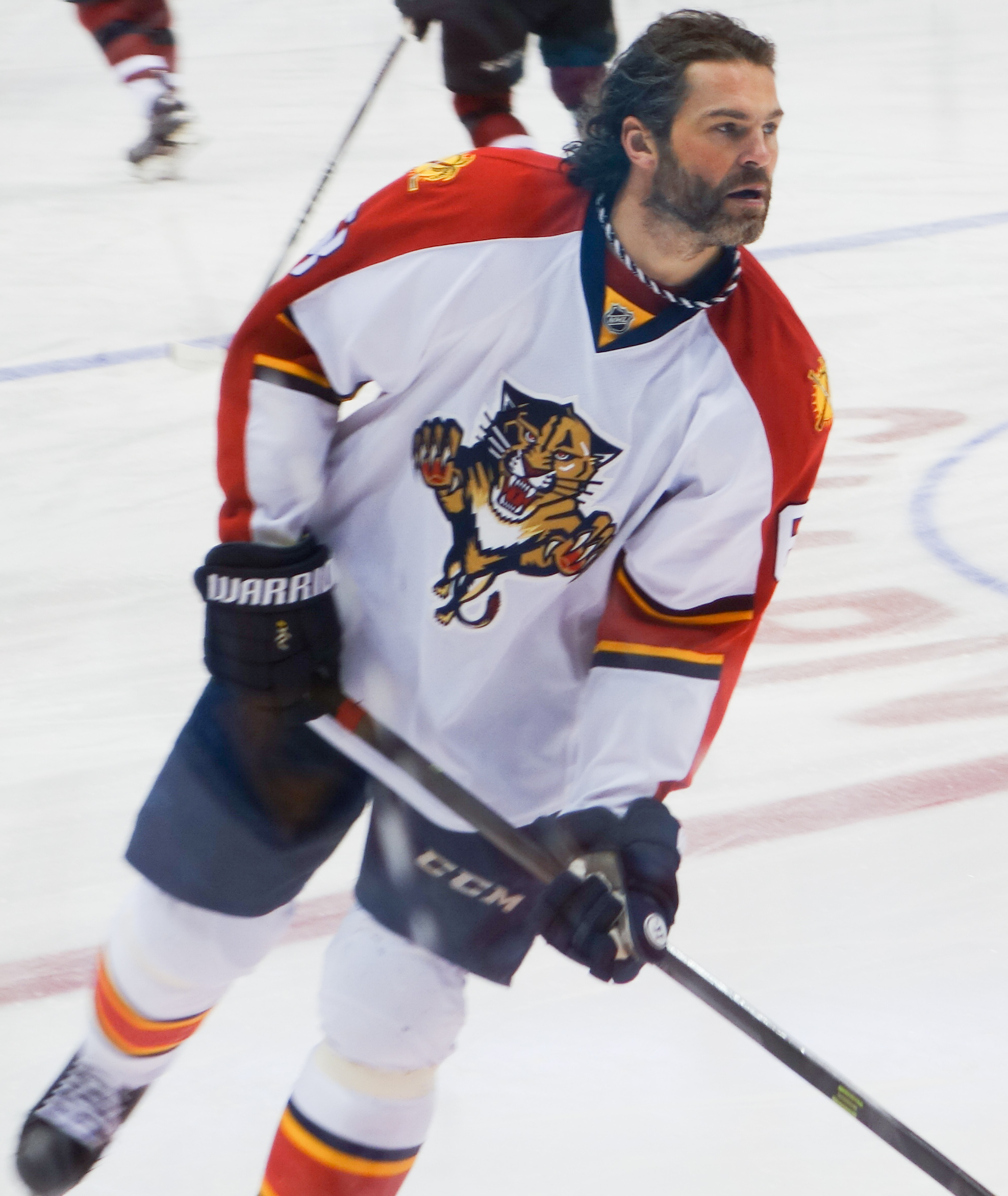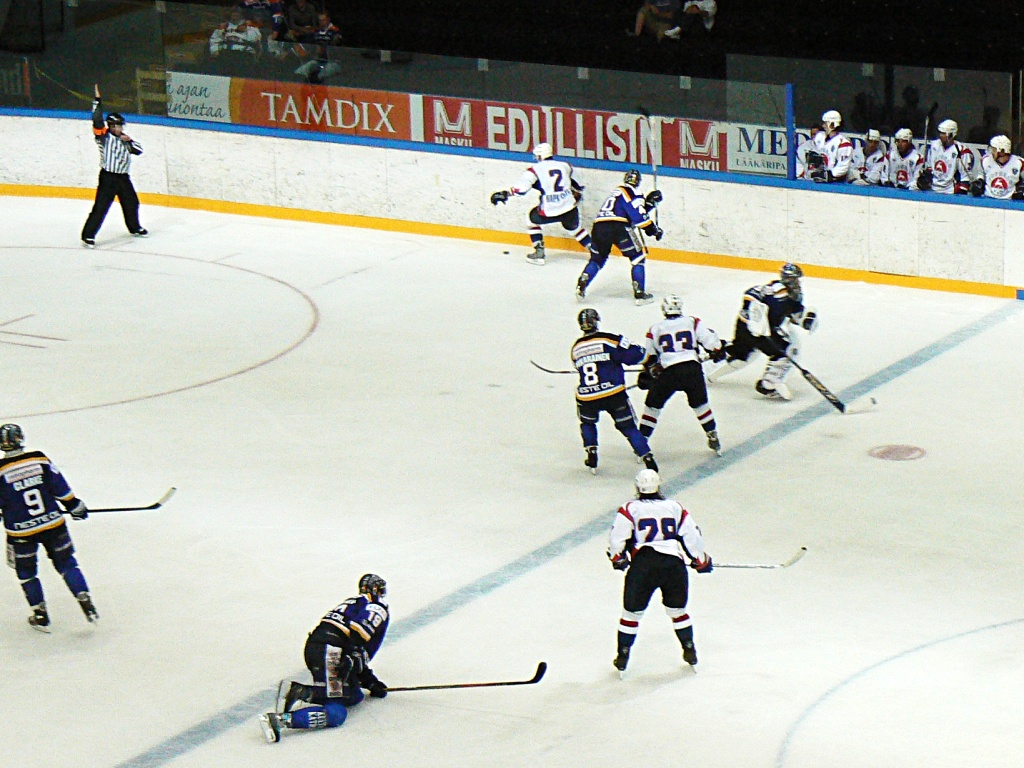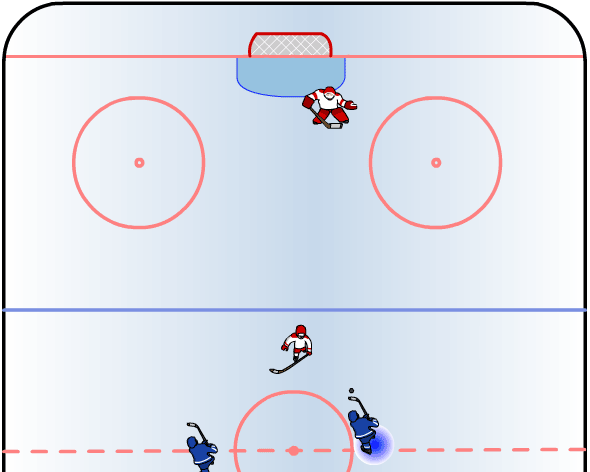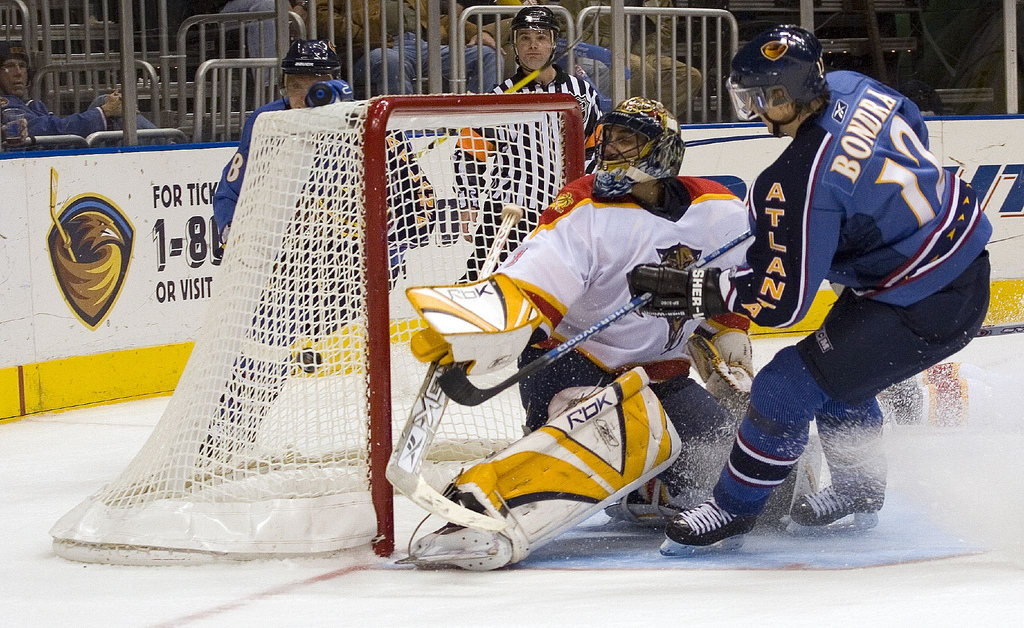|
Konstantin Shafranov
Konstantin Vitalievich Shafranov (russian: Константи́н Вита́льевич Шафра́нов) (born September 11, 1968) is a Kazakhstani former professional ice hockey player who played five games in the National Hockey League. He played for the St. Louis Blues. In 1996, he won the Gary F. Longman Memorial Trophy as the best rookie in the International Hockey League (IHL). Two years later he was named to the IHL's end of season all-star team, as the second best right-wing in the league. He is currently the Fort Wayne Komets' Assistant Coach. Career A long time veteran with his hometown club Torpedo Ust-Kamenogorsk, Shafranov was drafted by the St. Louis Blues 229th overall in the 1996 NHL Entry Draft. He made an immediate impact in North America, scoring 46 goals with the Fort Wayne Komets of the International Hockey League, earning himself the title of rookie of the year and a spot on the IHL's second All-Star Team. The following season, he made his NHL d ... [...More Info...] [...Related Items...] OR: [Wikipedia] [Google] [Baidu] |
Winger (ice Hockey)
Winger, in the game of ice hockey, is a forward position of a player whose primary zone of play is along the outer playing areas. They typically flank the centre forward. Originally the name was given to forward players who went up and down the sides of the rink. Wingers generally have the least defensive responsibilities out of any position on the ice, however they are still tasked with defensive duties such as forechecking duties or covering the point in the defensive zone. Nowadays, there are different types of wingers in the game — out-and-out goal scorers, checkers who disrupt the opponents, and forwards who work along the boards and in the corners. Often a winger's precise role on a line depends upon what type of role the other winger plays; usually lines will have one more goal-scoring oriented winger and one winger more focused on playing the boards, checking and passing the puck to others to take shots (if a larger player, he will sometimes be called a "power forward ... [...More Info...] [...Related Items...] OR: [Wikipedia] [Google] [Baidu] |
1996 NHL Entry Draft
The 1996 NHL Entry Draft was the 34th NHL Entry Draft. It was held at the Kiel Center in St. Louis, Missouri, on June 22, 1996. The last active player in the NHL from this draft class was Zdeno Chára, who retired after the 2021–22 season. Selections by round Club teams are located in North America unless otherwise noted. Round one Round two Round three Round four Round five Round six Round seven Round eight Round nine Draftees based on nationality See also * 1996–97 NHL season * List of NHL players References www.hockeydb.com External links aThe Internet Hockey Database {{1996–97 NHL season by team Draft Draft, The Draft, or Draught may refer to: Watercraft dimensions * Draft (hull), the distance from waterline to keel of a vessel * Draft (sail), degree of curvature in a sail * Air draft, distance from waterline to the highest point on a vesse ... National Hockey League Entry Draft ... [...More Info...] [...Related Items...] OR: [Wikipedia] [Google] [Baidu] |
Pervaya Liga (Soviet Union)
The Pervaya Liga was the second level of ice hockey in the Soviet Union, below the Soviet Championship League The Soviet Hockey Championship (russian: Чемпионат СССР по хоккею) was the highest level ice hockey league in the Soviet Union, running from 1946 to 1992. Before the 1940s the game of ice hockey was not cultivated in Russia, i .... The league was first contested during the 1947–48 season. on hockeyarchives.ru References {{Pervaya Liga (Soviet Union) seasons 2 ...[...More Info...] [...Related Items...] OR: [Wikipedia] [Google] [Baidu] |
Torpedo Ust–Kamenogorsk
Torpedo Hockey Club ( kk, «Торпедо» хоккей клубы, ''«Torpedo» hokkeı klýby''; russian: Хоккейный клуб «Торпедо»), commonly referred to as Torpedo Ust-Kamenogorsk, formerly known as Kazzinc-Torpedo (1999–2015), is a professional ice hockey team based in Oskemen, Kazakhstan. Torpedo has typically been the most dominant developmental club in Kazakhstan and its senior level team also plays at the Supreme Hockey League (VHL), one step below the Kontinental Hockey League (KHL). Most Kazakh players who have reached the National Hockey League (NHL) trace their roots to Torpedo. Kazzinc-Torpedo is the most crowned Kazakhstan team, with 13 championship wins. History 1955–1992: the Soviet era The Torpedo were founded by Nikolai Konyakhin in 1955. Konyakhin was a former ice hockey player and he had experience of playing for a youth team of the Moscow region. Father and son Konaykhin's have initiated the foundation of the amateur team at the Ulb ... [...More Info...] [...Related Items...] OR: [Wikipedia] [Google] [Baidu] |
Penalty (ice Hockey)
A penalty in ice hockey is a punishment for an infringement of the rules. Most penalties are enforced by sending the offending player to a penalty box for a set number of minutes. During the penalty the player may not participate in play. Penalties are called and enforced by the referee, or in some cases, the linesman. The offending team may not replace the player on the ice (although there are some exceptions, such as fighting), leaving them short-handed as opposed to full strength. When the opposing team is said to be on a ''power play'', they will have one more player on the ice than the short-handed team. The short-handed team is said to be "on the penalty kill" until the penalty expires and the penalized player returns to play. While standards vary somewhat between leagues, most leagues recognize several common varieties of penalties, as well as common infractions. The statistic used to track penalties is called "penalty minutes" and abbreviated to "PIM" (spoken as single w ... [...More Info...] [...Related Items...] OR: [Wikipedia] [Google] [Baidu] |
Point (ice Hockey)
In ice hockey, point has three contemporary meanings. Personal stat A point is awarded to a player for each goal scored or assist earned. The total number of goals plus assists equals total points. The Art Ross Trophy is awarded to the National Hockey League (NHL) player who leads the league in scoring points at the end of the regular season. Team stat Points are also awarded to assess standings (or rankings). Historically, teams were awarded two points for each win, one point for each tie and no points for a loss. Such a ranking system, implemented primarily to ensure a tie counted as a "half-win" for each team in the standings, is generally regarded as British and/or European in origin and as such adopted by the National Hockey League which was founded in Canada where leagues generally used ranking systems of British origin. Awarding points in the standings contrasts with traditional American ranking systems favored in sports originating within the United States where today the m ... [...More Info...] [...Related Items...] OR: [Wikipedia] [Google] [Baidu] |
Assist (ice Hockey)
In ice hockey, an assist is attributed to up to two players of the scoring team who shot, passed or deflected the puck towards the scoring teammate, or touched it in any other way which enabled the goal, meaning that they were "assisting" in the goal. There can be a maximum of two assists per goal. The assists will be awarded in the order of play, with the last player to pass the puck to the goal scorer getting the primary assist and the player who passed it to the primary assister getting the secondary assist. Players who gain an assist will get one point added to their player statistics. Despite the use of the terms "primary assist" and "secondary assist", neither is worth more than the other, and neither is worth more or less than a goal. Assists and goals are added together on a player's scoresheet to display that player's total points. Special cases If a player scores off a rebound given up by a goaltender, assists are still awarded, as long as there is no re-possession by t ... [...More Info...] [...Related Items...] OR: [Wikipedia] [Google] [Baidu] |
Goal (ice Hockey)
In ice hockey, a goal is scored when the puck entirely crosses the goal line between the two goal posts and below the goal crossbar. A goal awards one point to the team attacking the goal scored upon, regardless of which team the player who actually deflected the puck into the goal belongs to (see also own goal). Typically, a player on the team attempting to score shoots the puck with their stick towards the goal net opening, and a player on the opposing team called a goaltender tries to block the shot to prevent a goal from being scored against their team. The term goal may also refer to the structure in which goals are scored. The ice hockey goal is rectangular in shape; the front frame of the goal is made of steel tube painted red (blue in the ECHL because of a sponsorship deal with GEICO) and consists of two vertical goalposts and a horizontal crossbar. A net is attached to the back of the frame to catch pucks that enter the goal and also to prevent pucks from entering it ... [...More Info...] [...Related Items...] OR: [Wikipedia] [Google] [Baidu] |
Season (sports)
In an organized sports league, a typical season is the portion of one year in which regulated games of the sport are in session: for example, in Major League Baseball the season lasts approximately from the last week of March to the last week of September. In other team sports, like association football or basketball, it is generally from August or September to May although in some countries - such as Northern Europe or East Asia - the season starts in the spring and finishes in autumn, mainly due to weather conditions encountered during the winter. A year can often be broken up into several distinct sections (sometimes themselves called seasons). These are: a preseason, a series of exhibition games played for training purposes; a regular season, the main period of the league's competition; the postseason, a playoff tournament played against the league's top teams to determine the league's champion; and the offseason, the time when there is no official competition. Preseason In ... [...More Info...] [...Related Items...] OR: [Wikipedia] [Google] [Baidu] |
Playoffs
The playoffs, play-offs, postseason or finals of a sports league are a competition played after the regular season by the top competitors to determine the league champion or a similar accolade. Depending on the league, the playoffs may be either a single game, a series of games, or a tournament, and may use a single-elimination system or one of several other different playoff formats. Playoff, in regard to international fixtures, is to qualify or progress to the next round of a competition or tournament. In team sports in the U.S. and Canada, the vast distances and consequent burdens on cross-country travel have led to regional divisions of teams. Generally, during the regular season, teams play more games in their division than outside it, but the league's best teams might not play against each other in the regular season. Therefore, in the postseason a playoff series is organized. Any group-winning team is eligible to participate, and as playoffs became more popular they were ... [...More Info...] [...Related Items...] OR: [Wikipedia] [Google] [Baidu] |
Regular Season
In an organized sports league, a typical season is the portion of one year in which regulated games of the sport are in session: for example, in Major League Baseball the season lasts approximately from the last week of March to the last week of September. In other team sports, like association football or basketball, it is generally from August or September to May although in some countries - such as Northern Europe or East Asia - the season starts in the spring and finishes in autumn, mainly due to weather conditions encountered during the winter. A year can often be broken up into several distinct sections (sometimes themselves called seasons). These are: a preseason, a series of exhibition games played for training purposes; a regular season, the main period of the league's competition; the postseason, a playoff tournament played against the league's top teams to determine the league's champion; and the offseason, the time when there is no official competition. Preseason In ... [...More Info...] [...Related Items...] OR: [Wikipedia] [Google] [Baidu] |
Kazakhstan Men's National Ice Hockey Team
The Kazakhstan men's national ice hockey team is controlled by Kazakhstan Ice Hockey Federation. Kazakhstan is ranked 16th in the world as of 2022. They have competed at the Winter Olympics twice, in 1998 and 2006. The national team joined the IIHF in 1992 and first played internationally at the 1993 Men's World Ice Hockey Championships. The team has frequently played at the elite division of the World Championship, often moving between there and the Division I level. History Kazakhstan joined the IIHF in 1992, applying as a separate member with six other former Soviet republics. They played their first IIHF tournament at the 1993 World Championship; as a new member they had to play in Group C, the lowest level. They reached the elite division for the first time in 1998, and have played at the elite level seven times (1998, 2004, 2005, 2006, 2010, 2012, 2014 and 2016). The national team has appeared at the Winter Olympics twice, in 1998 and 2006. In their debut in 1998, t ... [...More Info...] [...Related Items...] OR: [Wikipedia] [Google] [Baidu] |





